Impact of 5G on Profitability and Customer Services of Dell
VerifiedAdded on 2023/01/17
|15
|5114
|56
AI Summary
This literature review discusses the IT industry in New Zealand, the areas of IT influenced by 5G, and the positive and negative impact of 5G on profitability and customer services of Dell. It also explores the literature perspective on the adoption of 5G in other countries. The research proposal section outlines the research problem and methodology. The questionnaire section presents ethical considerations and sample questions. The document concludes with a list of references.
Contribute Materials
Your contribution can guide someone’s learning journey. Share your
documents today.

Applied Management
Secure Best Marks with AI Grader
Need help grading? Try our AI Grader for instant feedback on your assignments.
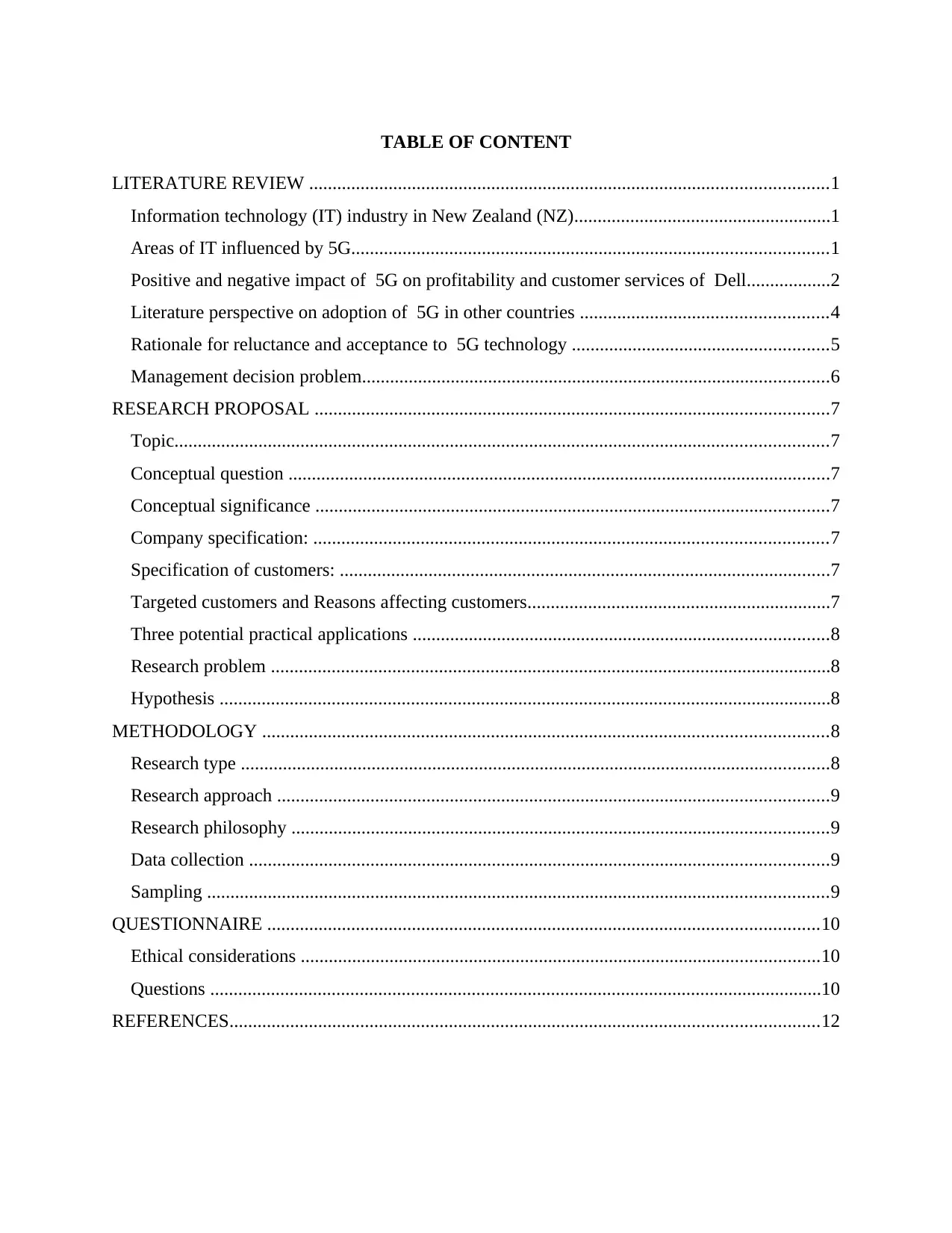
TABLE OF CONTENT
LITERATURE REVIEW ...............................................................................................................1
Information technology (IT) industry in New Zealand (NZ).......................................................1
Areas of IT influenced by 5G......................................................................................................1
Positive and negative impact of 5G on profitability and customer services of Dell..................2
Literature perspective on adoption of 5G in other countries .....................................................4
Rationale for reluctance and acceptance to 5G technology .......................................................5
Management decision problem....................................................................................................6
RESEARCH PROPOSAL ..............................................................................................................7
Topic............................................................................................................................................7
Conceptual question ....................................................................................................................7
Conceptual significance ..............................................................................................................7
Company specification: ..............................................................................................................7
Specification of customers: .........................................................................................................7
Targeted customers and Reasons affecting customers.................................................................7
Three potential practical applications .........................................................................................8
Research problem ........................................................................................................................8
Hypothesis ...................................................................................................................................8
METHODOLOGY .........................................................................................................................8
Research type ..............................................................................................................................8
Research approach ......................................................................................................................9
Research philosophy ...................................................................................................................9
Data collection ............................................................................................................................9
Sampling .....................................................................................................................................9
QUESTIONNAIRE ......................................................................................................................10
Ethical considerations ...............................................................................................................10
Questions ...................................................................................................................................10
REFERENCES..............................................................................................................................12
LITERATURE REVIEW ...............................................................................................................1
Information technology (IT) industry in New Zealand (NZ).......................................................1
Areas of IT influenced by 5G......................................................................................................1
Positive and negative impact of 5G on profitability and customer services of Dell..................2
Literature perspective on adoption of 5G in other countries .....................................................4
Rationale for reluctance and acceptance to 5G technology .......................................................5
Management decision problem....................................................................................................6
RESEARCH PROPOSAL ..............................................................................................................7
Topic............................................................................................................................................7
Conceptual question ....................................................................................................................7
Conceptual significance ..............................................................................................................7
Company specification: ..............................................................................................................7
Specification of customers: .........................................................................................................7
Targeted customers and Reasons affecting customers.................................................................7
Three potential practical applications .........................................................................................8
Research problem ........................................................................................................................8
Hypothesis ...................................................................................................................................8
METHODOLOGY .........................................................................................................................8
Research type ..............................................................................................................................8
Research approach ......................................................................................................................9
Research philosophy ...................................................................................................................9
Data collection ............................................................................................................................9
Sampling .....................................................................................................................................9
QUESTIONNAIRE ......................................................................................................................10
Ethical considerations ...............................................................................................................10
Questions ...................................................................................................................................10
REFERENCES..............................................................................................................................12
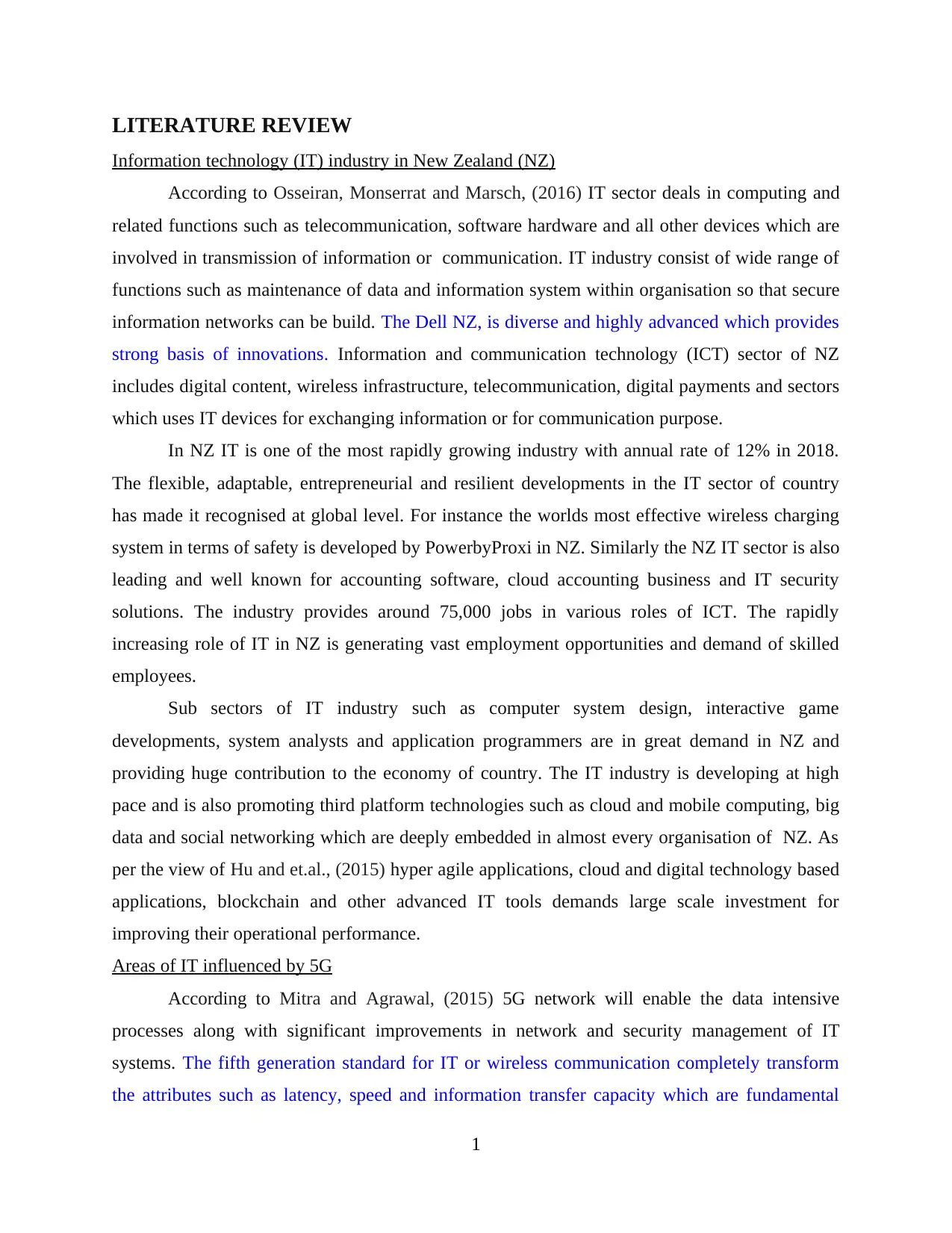
LITERATURE REVIEW
Information technology (IT) industry in New Zealand (NZ)
According to Osseiran, Monserrat and Marsch, (2016) IT sector deals in computing and
related functions such as telecommunication, software hardware and all other devices which are
involved in transmission of information or communication. IT industry consist of wide range of
functions such as maintenance of data and information system within organisation so that secure
information networks can be build. The Dell NZ, is diverse and highly advanced which provides
strong basis of innovations. Information and communication technology (ICT) sector of NZ
includes digital content, wireless infrastructure, telecommunication, digital payments and sectors
which uses IT devices for exchanging information or for communication purpose.
In NZ IT is one of the most rapidly growing industry with annual rate of 12% in 2018.
The flexible, adaptable, entrepreneurial and resilient developments in the IT sector of country
has made it recognised at global level. For instance the worlds most effective wireless charging
system in terms of safety is developed by PowerbyProxi in NZ. Similarly the NZ IT sector is also
leading and well known for accounting software, cloud accounting business and IT security
solutions. The industry provides around 75,000 jobs in various roles of ICT. The rapidly
increasing role of IT in NZ is generating vast employment opportunities and demand of skilled
employees.
Sub sectors of IT industry such as computer system design, interactive game
developments, system analysts and application programmers are in great demand in NZ and
providing huge contribution to the economy of country. The IT industry is developing at high
pace and is also promoting third platform technologies such as cloud and mobile computing, big
data and social networking which are deeply embedded in almost every organisation of NZ. As
per the view of Hu and et.al., (2015) hyper agile applications, cloud and digital technology based
applications, blockchain and other advanced IT tools demands large scale investment for
improving their operational performance.
Areas of IT influenced by 5G
According to Mitra and Agrawal, (2015) 5G network will enable the data intensive
processes along with significant improvements in network and security management of IT
systems. The fifth generation standard for IT or wireless communication completely transform
the attributes such as latency, speed and information transfer capacity which are fundamental
1
Information technology (IT) industry in New Zealand (NZ)
According to Osseiran, Monserrat and Marsch, (2016) IT sector deals in computing and
related functions such as telecommunication, software hardware and all other devices which are
involved in transmission of information or communication. IT industry consist of wide range of
functions such as maintenance of data and information system within organisation so that secure
information networks can be build. The Dell NZ, is diverse and highly advanced which provides
strong basis of innovations. Information and communication technology (ICT) sector of NZ
includes digital content, wireless infrastructure, telecommunication, digital payments and sectors
which uses IT devices for exchanging information or for communication purpose.
In NZ IT is one of the most rapidly growing industry with annual rate of 12% in 2018.
The flexible, adaptable, entrepreneurial and resilient developments in the IT sector of country
has made it recognised at global level. For instance the worlds most effective wireless charging
system in terms of safety is developed by PowerbyProxi in NZ. Similarly the NZ IT sector is also
leading and well known for accounting software, cloud accounting business and IT security
solutions. The industry provides around 75,000 jobs in various roles of ICT. The rapidly
increasing role of IT in NZ is generating vast employment opportunities and demand of skilled
employees.
Sub sectors of IT industry such as computer system design, interactive game
developments, system analysts and application programmers are in great demand in NZ and
providing huge contribution to the economy of country. The IT industry is developing at high
pace and is also promoting third platform technologies such as cloud and mobile computing, big
data and social networking which are deeply embedded in almost every organisation of NZ. As
per the view of Hu and et.al., (2015) hyper agile applications, cloud and digital technology based
applications, blockchain and other advanced IT tools demands large scale investment for
improving their operational performance.
Areas of IT influenced by 5G
According to Mitra and Agrawal, (2015) 5G network will enable the data intensive
processes along with significant improvements in network and security management of IT
systems. The fifth generation standard for IT or wireless communication completely transform
the attributes such as latency, speed and information transfer capacity which are fundamental
1
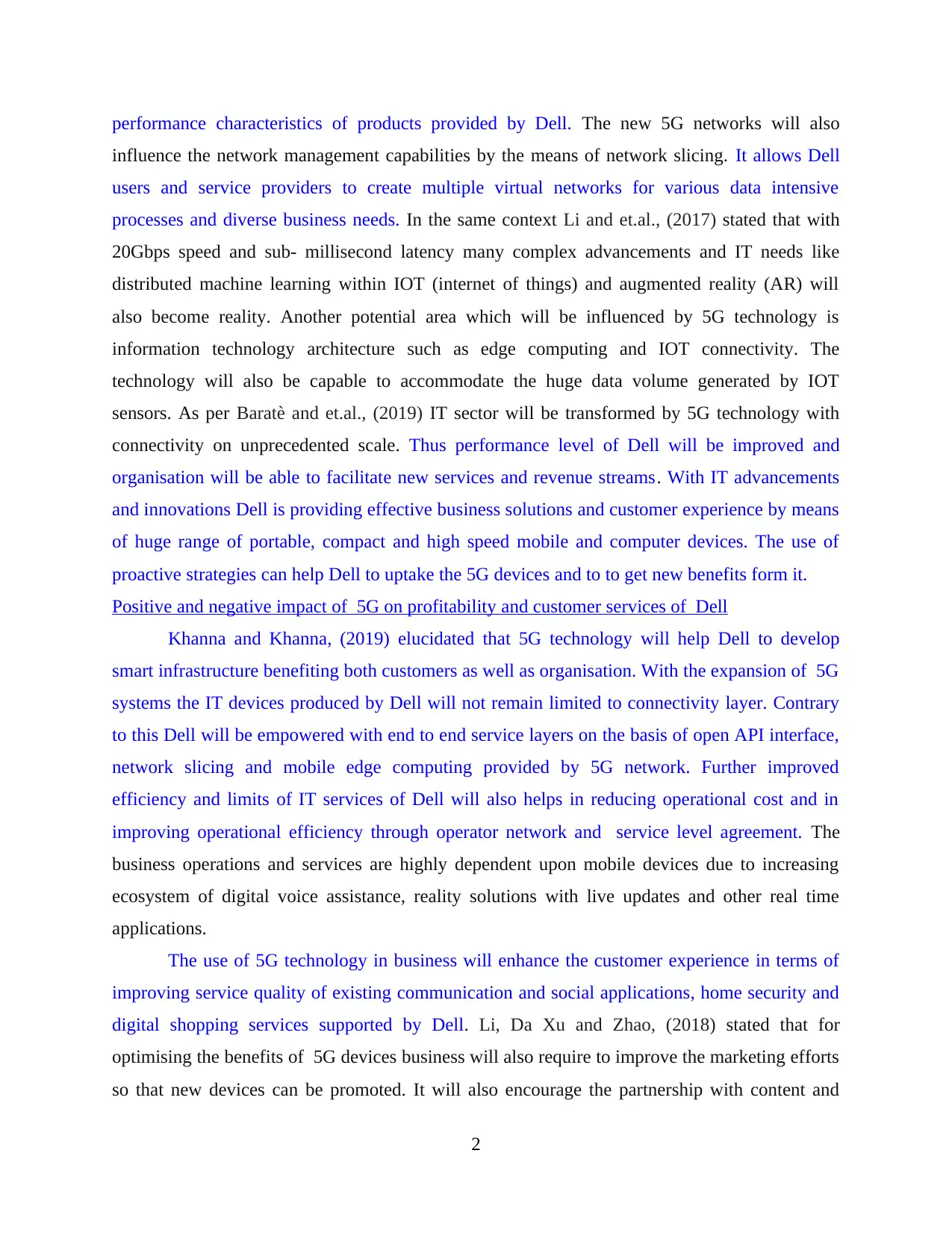
performance characteristics of products provided by Dell. The new 5G networks will also
influence the network management capabilities by the means of network slicing. It allows Dell
users and service providers to create multiple virtual networks for various data intensive
processes and diverse business needs. In the same context Li and et.al., (2017) stated that with
20Gbps speed and sub- millisecond latency many complex advancements and IT needs like
distributed machine learning within IOT (internet of things) and augmented reality (AR) will
also become reality. Another potential area which will be influenced by 5G technology is
information technology architecture such as edge computing and IOT connectivity. The
technology will also be capable to accommodate the huge data volume generated by IOT
sensors. As per Baratè and et.al., (2019) IT sector will be transformed by 5G technology with
connectivity on unprecedented scale. Thus performance level of Dell will be improved and
organisation will be able to facilitate new services and revenue streams. With IT advancements
and innovations Dell is providing effective business solutions and customer experience by means
of huge range of portable, compact and high speed mobile and computer devices. The use of
proactive strategies can help Dell to uptake the 5G devices and to to get new benefits form it.
Positive and negative impact of 5G on profitability and customer services of Dell
Khanna and Khanna, (2019) elucidated that 5G technology will help Dell to develop
smart infrastructure benefiting both customers as well as organisation. With the expansion of 5G
systems the IT devices produced by Dell will not remain limited to connectivity layer. Contrary
to this Dell will be empowered with end to end service layers on the basis of open API interface,
network slicing and mobile edge computing provided by 5G network. Further improved
efficiency and limits of IT services of Dell will also helps in reducing operational cost and in
improving operational efficiency through operator network and service level agreement. The
business operations and services are highly dependent upon mobile devices due to increasing
ecosystem of digital voice assistance, reality solutions with live updates and other real time
applications.
The use of 5G technology in business will enhance the customer experience in terms of
improving service quality of existing communication and social applications, home security and
digital shopping services supported by Dell. Li, Da Xu and Zhao, (2018) stated that for
optimising the benefits of 5G devices business will also require to improve the marketing efforts
so that new devices can be promoted. It will also encourage the partnership with content and
2
influence the network management capabilities by the means of network slicing. It allows Dell
users and service providers to create multiple virtual networks for various data intensive
processes and diverse business needs. In the same context Li and et.al., (2017) stated that with
20Gbps speed and sub- millisecond latency many complex advancements and IT needs like
distributed machine learning within IOT (internet of things) and augmented reality (AR) will
also become reality. Another potential area which will be influenced by 5G technology is
information technology architecture such as edge computing and IOT connectivity. The
technology will also be capable to accommodate the huge data volume generated by IOT
sensors. As per Baratè and et.al., (2019) IT sector will be transformed by 5G technology with
connectivity on unprecedented scale. Thus performance level of Dell will be improved and
organisation will be able to facilitate new services and revenue streams. With IT advancements
and innovations Dell is providing effective business solutions and customer experience by means
of huge range of portable, compact and high speed mobile and computer devices. The use of
proactive strategies can help Dell to uptake the 5G devices and to to get new benefits form it.
Positive and negative impact of 5G on profitability and customer services of Dell
Khanna and Khanna, (2019) elucidated that 5G technology will help Dell to develop
smart infrastructure benefiting both customers as well as organisation. With the expansion of 5G
systems the IT devices produced by Dell will not remain limited to connectivity layer. Contrary
to this Dell will be empowered with end to end service layers on the basis of open API interface,
network slicing and mobile edge computing provided by 5G network. Further improved
efficiency and limits of IT services of Dell will also helps in reducing operational cost and in
improving operational efficiency through operator network and service level agreement. The
business operations and services are highly dependent upon mobile devices due to increasing
ecosystem of digital voice assistance, reality solutions with live updates and other real time
applications.
The use of 5G technology in business will enhance the customer experience in terms of
improving service quality of existing communication and social applications, home security and
digital shopping services supported by Dell. Li, Da Xu and Zhao, (2018) stated that for
optimising the benefits of 5G devices business will also require to improve the marketing efforts
so that new devices can be promoted. It will also encourage the partnership with content and
2
Secure Best Marks with AI Grader
Need help grading? Try our AI Grader for instant feedback on your assignments.
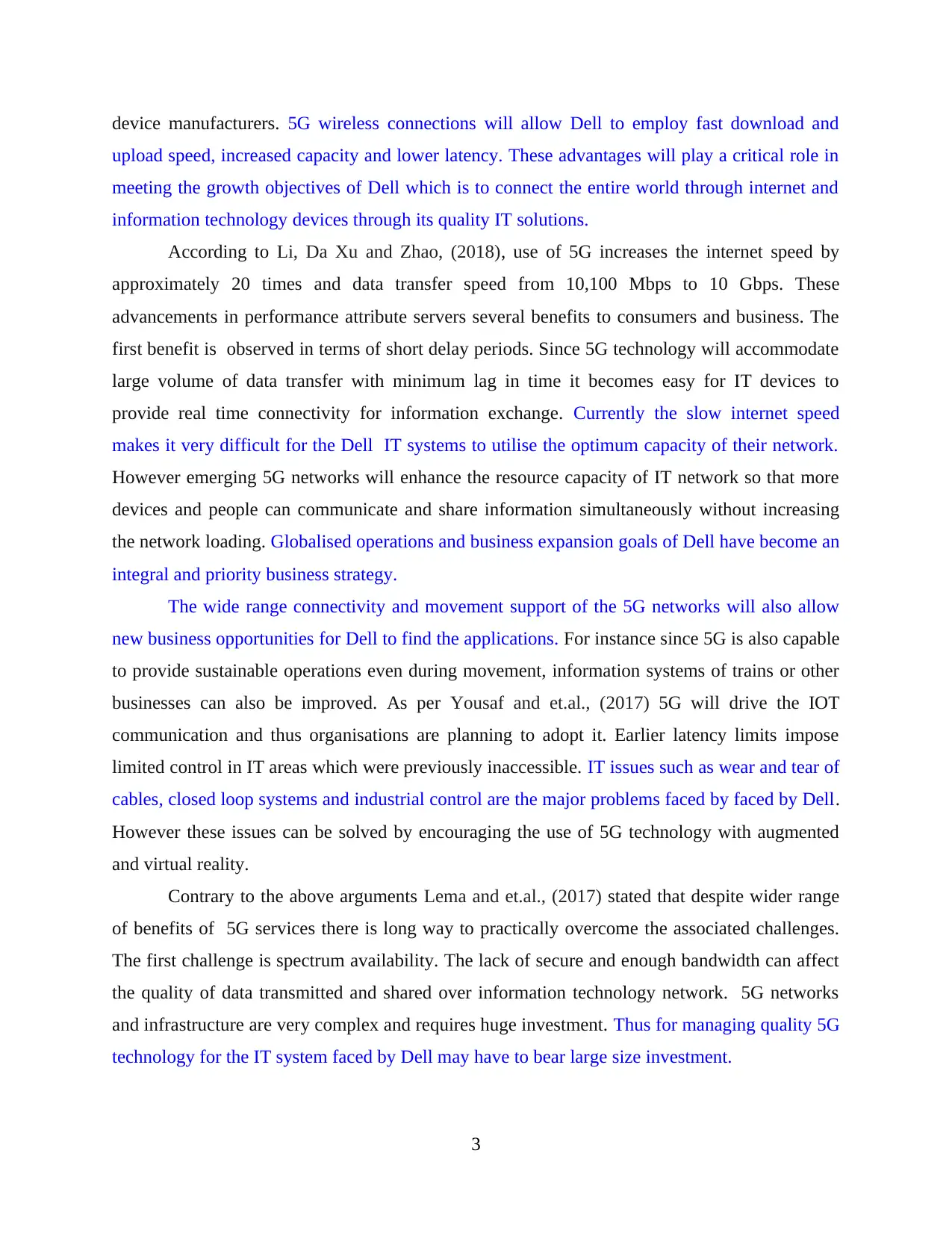
device manufacturers. 5G wireless connections will allow Dell to employ fast download and
upload speed, increased capacity and lower latency. These advantages will play a critical role in
meeting the growth objectives of Dell which is to connect the entire world through internet and
information technology devices through its quality IT solutions.
According to Li, Da Xu and Zhao, (2018), use of 5G increases the internet speed by
approximately 20 times and data transfer speed from 10,100 Mbps to 10 Gbps. These
advancements in performance attribute servers several benefits to consumers and business. The
first benefit is observed in terms of short delay periods. Since 5G technology will accommodate
large volume of data transfer with minimum lag in time it becomes easy for IT devices to
provide real time connectivity for information exchange. Currently the slow internet speed
makes it very difficult for the Dell IT systems to utilise the optimum capacity of their network.
However emerging 5G networks will enhance the resource capacity of IT network so that more
devices and people can communicate and share information simultaneously without increasing
the network loading. Globalised operations and business expansion goals of Dell have become an
integral and priority business strategy.
The wide range connectivity and movement support of the 5G networks will also allow
new business opportunities for Dell to find the applications. For instance since 5G is also capable
to provide sustainable operations even during movement, information systems of trains or other
businesses can also be improved. As per Yousaf and et.al., (2017) 5G will drive the IOT
communication and thus organisations are planning to adopt it. Earlier latency limits impose
limited control in IT areas which were previously inaccessible. IT issues such as wear and tear of
cables, closed loop systems and industrial control are the major problems faced by faced by Dell.
However these issues can be solved by encouraging the use of 5G technology with augmented
and virtual reality.
Contrary to the above arguments Lema and et.al., (2017) stated that despite wider range
of benefits of 5G services there is long way to practically overcome the associated challenges.
The first challenge is spectrum availability. The lack of secure and enough bandwidth can affect
the quality of data transmitted and shared over information technology network. 5G networks
and infrastructure are very complex and requires huge investment. Thus for managing quality 5G
technology for the IT system faced by Dell may have to bear large size investment.
3
upload speed, increased capacity and lower latency. These advantages will play a critical role in
meeting the growth objectives of Dell which is to connect the entire world through internet and
information technology devices through its quality IT solutions.
According to Li, Da Xu and Zhao, (2018), use of 5G increases the internet speed by
approximately 20 times and data transfer speed from 10,100 Mbps to 10 Gbps. These
advancements in performance attribute servers several benefits to consumers and business. The
first benefit is observed in terms of short delay periods. Since 5G technology will accommodate
large volume of data transfer with minimum lag in time it becomes easy for IT devices to
provide real time connectivity for information exchange. Currently the slow internet speed
makes it very difficult for the Dell IT systems to utilise the optimum capacity of their network.
However emerging 5G networks will enhance the resource capacity of IT network so that more
devices and people can communicate and share information simultaneously without increasing
the network loading. Globalised operations and business expansion goals of Dell have become an
integral and priority business strategy.
The wide range connectivity and movement support of the 5G networks will also allow
new business opportunities for Dell to find the applications. For instance since 5G is also capable
to provide sustainable operations even during movement, information systems of trains or other
businesses can also be improved. As per Yousaf and et.al., (2017) 5G will drive the IOT
communication and thus organisations are planning to adopt it. Earlier latency limits impose
limited control in IT areas which were previously inaccessible. IT issues such as wear and tear of
cables, closed loop systems and industrial control are the major problems faced by faced by Dell.
However these issues can be solved by encouraging the use of 5G technology with augmented
and virtual reality.
Contrary to the above arguments Lema and et.al., (2017) stated that despite wider range
of benefits of 5G services there is long way to practically overcome the associated challenges.
The first challenge is spectrum availability. The lack of secure and enough bandwidth can affect
the quality of data transmitted and shared over information technology network. 5G networks
and infrastructure are very complex and requires huge investment. Thus for managing quality 5G
technology for the IT system faced by Dell may have to bear large size investment.
3
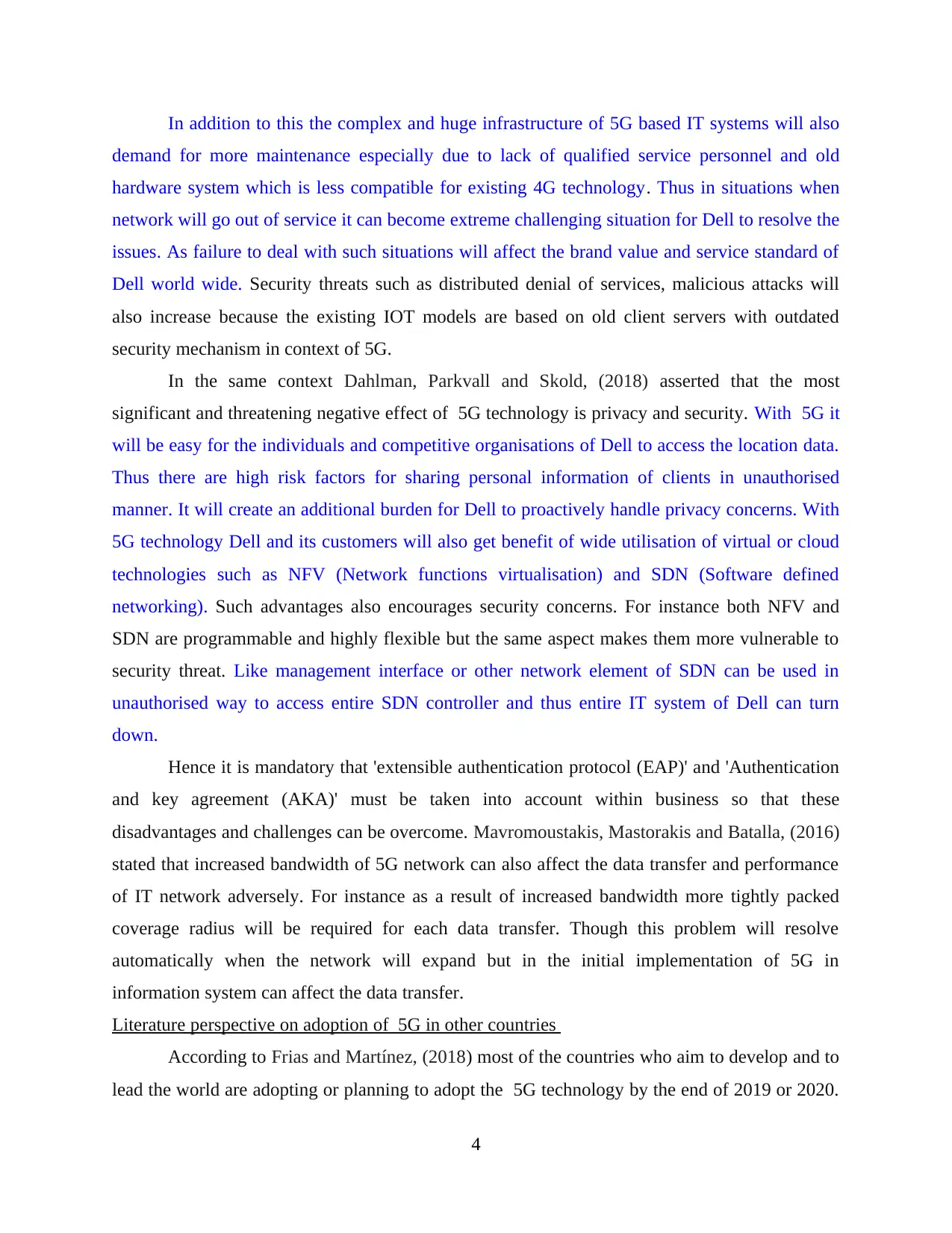
In addition to this the complex and huge infrastructure of 5G based IT systems will also
demand for more maintenance especially due to lack of qualified service personnel and old
hardware system which is less compatible for existing 4G technology. Thus in situations when
network will go out of service it can become extreme challenging situation for Dell to resolve the
issues. As failure to deal with such situations will affect the brand value and service standard of
Dell world wide. Security threats such as distributed denial of services, malicious attacks will
also increase because the existing IOT models are based on old client servers with outdated
security mechanism in context of 5G.
In the same context Dahlman, Parkvall and Skold, (2018) asserted that the most
significant and threatening negative effect of 5G technology is privacy and security. With 5G it
will be easy for the individuals and competitive organisations of Dell to access the location data.
Thus there are high risk factors for sharing personal information of clients in unauthorised
manner. It will create an additional burden for Dell to proactively handle privacy concerns. With
5G technology Dell and its customers will also get benefit of wide utilisation of virtual or cloud
technologies such as NFV (Network functions virtualisation) and SDN (Software defined
networking). Such advantages also encourages security concerns. For instance both NFV and
SDN are programmable and highly flexible but the same aspect makes them more vulnerable to
security threat. Like management interface or other network element of SDN can be used in
unauthorised way to access entire SDN controller and thus entire IT system of Dell can turn
down.
Hence it is mandatory that 'extensible authentication protocol (EAP)' and 'Authentication
and key agreement (AKA)' must be taken into account within business so that these
disadvantages and challenges can be overcome. Mavromoustakis, Mastorakis and Batalla, (2016)
stated that increased bandwidth of 5G network can also affect the data transfer and performance
of IT network adversely. For instance as a result of increased bandwidth more tightly packed
coverage radius will be required for each data transfer. Though this problem will resolve
automatically when the network will expand but in the initial implementation of 5G in
information system can affect the data transfer.
Literature perspective on adoption of 5G in other countries
According to Frias and Martínez, (2018) most of the countries who aim to develop and to
lead the world are adopting or planning to adopt the 5G technology by the end of 2019 or 2020.
4
demand for more maintenance especially due to lack of qualified service personnel and old
hardware system which is less compatible for existing 4G technology. Thus in situations when
network will go out of service it can become extreme challenging situation for Dell to resolve the
issues. As failure to deal with such situations will affect the brand value and service standard of
Dell world wide. Security threats such as distributed denial of services, malicious attacks will
also increase because the existing IOT models are based on old client servers with outdated
security mechanism in context of 5G.
In the same context Dahlman, Parkvall and Skold, (2018) asserted that the most
significant and threatening negative effect of 5G technology is privacy and security. With 5G it
will be easy for the individuals and competitive organisations of Dell to access the location data.
Thus there are high risk factors for sharing personal information of clients in unauthorised
manner. It will create an additional burden for Dell to proactively handle privacy concerns. With
5G technology Dell and its customers will also get benefit of wide utilisation of virtual or cloud
technologies such as NFV (Network functions virtualisation) and SDN (Software defined
networking). Such advantages also encourages security concerns. For instance both NFV and
SDN are programmable and highly flexible but the same aspect makes them more vulnerable to
security threat. Like management interface or other network element of SDN can be used in
unauthorised way to access entire SDN controller and thus entire IT system of Dell can turn
down.
Hence it is mandatory that 'extensible authentication protocol (EAP)' and 'Authentication
and key agreement (AKA)' must be taken into account within business so that these
disadvantages and challenges can be overcome. Mavromoustakis, Mastorakis and Batalla, (2016)
stated that increased bandwidth of 5G network can also affect the data transfer and performance
of IT network adversely. For instance as a result of increased bandwidth more tightly packed
coverage radius will be required for each data transfer. Though this problem will resolve
automatically when the network will expand but in the initial implementation of 5G in
information system can affect the data transfer.
Literature perspective on adoption of 5G in other countries
According to Frias and Martínez, (2018) most of the countries who aim to develop and to
lead the world are adopting or planning to adopt the 5G technology by the end of 2019 or 2020.
4
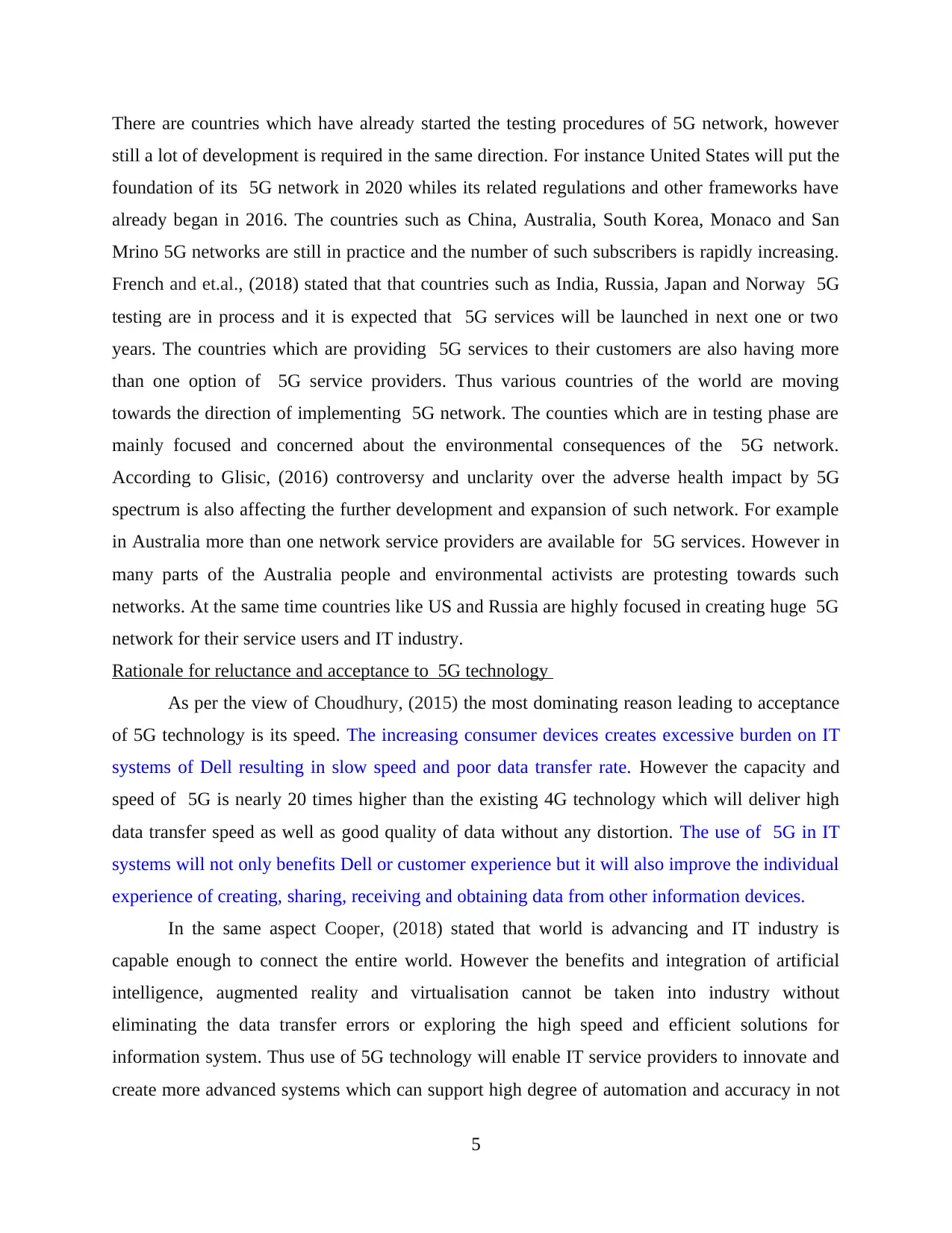
There are countries which have already started the testing procedures of 5G network, however
still a lot of development is required in the same direction. For instance United States will put the
foundation of its 5G network in 2020 whiles its related regulations and other frameworks have
already began in 2016. The countries such as China, Australia, South Korea, Monaco and San
Mrino 5G networks are still in practice and the number of such subscribers is rapidly increasing.
French and et.al., (2018) stated that that countries such as India, Russia, Japan and Norway 5G
testing are in process and it is expected that 5G services will be launched in next one or two
years. The countries which are providing 5G services to their customers are also having more
than one option of 5G service providers. Thus various countries of the world are moving
towards the direction of implementing 5G network. The counties which are in testing phase are
mainly focused and concerned about the environmental consequences of the 5G network.
According to Glisic, (2016) controversy and unclarity over the adverse health impact by 5G
spectrum is also affecting the further development and expansion of such network. For example
in Australia more than one network service providers are available for 5G services. However in
many parts of the Australia people and environmental activists are protesting towards such
networks. At the same time countries like US and Russia are highly focused in creating huge 5G
network for their service users and IT industry.
Rationale for reluctance and acceptance to 5G technology
As per the view of Choudhury, (2015) the most dominating reason leading to acceptance
of 5G technology is its speed. The increasing consumer devices creates excessive burden on IT
systems of Dell resulting in slow speed and poor data transfer rate. However the capacity and
speed of 5G is nearly 20 times higher than the existing 4G technology which will deliver high
data transfer speed as well as good quality of data without any distortion. The use of 5G in IT
systems will not only benefits Dell or customer experience but it will also improve the individual
experience of creating, sharing, receiving and obtaining data from other information devices.
In the same aspect Cooper, (2018) stated that world is advancing and IT industry is
capable enough to connect the entire world. However the benefits and integration of artificial
intelligence, augmented reality and virtualisation cannot be taken into industry without
eliminating the data transfer errors or exploring the high speed and efficient solutions for
information system. Thus use of 5G technology will enable IT service providers to innovate and
create more advanced systems which can support high degree of automation and accuracy in not
5
still a lot of development is required in the same direction. For instance United States will put the
foundation of its 5G network in 2020 whiles its related regulations and other frameworks have
already began in 2016. The countries such as China, Australia, South Korea, Monaco and San
Mrino 5G networks are still in practice and the number of such subscribers is rapidly increasing.
French and et.al., (2018) stated that that countries such as India, Russia, Japan and Norway 5G
testing are in process and it is expected that 5G services will be launched in next one or two
years. The countries which are providing 5G services to their customers are also having more
than one option of 5G service providers. Thus various countries of the world are moving
towards the direction of implementing 5G network. The counties which are in testing phase are
mainly focused and concerned about the environmental consequences of the 5G network.
According to Glisic, (2016) controversy and unclarity over the adverse health impact by 5G
spectrum is also affecting the further development and expansion of such network. For example
in Australia more than one network service providers are available for 5G services. However in
many parts of the Australia people and environmental activists are protesting towards such
networks. At the same time countries like US and Russia are highly focused in creating huge 5G
network for their service users and IT industry.
Rationale for reluctance and acceptance to 5G technology
As per the view of Choudhury, (2015) the most dominating reason leading to acceptance
of 5G technology is its speed. The increasing consumer devices creates excessive burden on IT
systems of Dell resulting in slow speed and poor data transfer rate. However the capacity and
speed of 5G is nearly 20 times higher than the existing 4G technology which will deliver high
data transfer speed as well as good quality of data without any distortion. The use of 5G in IT
systems will not only benefits Dell or customer experience but it will also improve the individual
experience of creating, sharing, receiving and obtaining data from other information devices.
In the same aspect Cooper, (2018) stated that world is advancing and IT industry is
capable enough to connect the entire world. However the benefits and integration of artificial
intelligence, augmented reality and virtualisation cannot be taken into industry without
eliminating the data transfer errors or exploring the high speed and efficient solutions for
information system. Thus use of 5G technology will enable IT service providers to innovate and
create more advanced systems which can support high degree of automation and accuracy in not
5
Paraphrase This Document
Need a fresh take? Get an instant paraphrase of this document with our AI Paraphraser
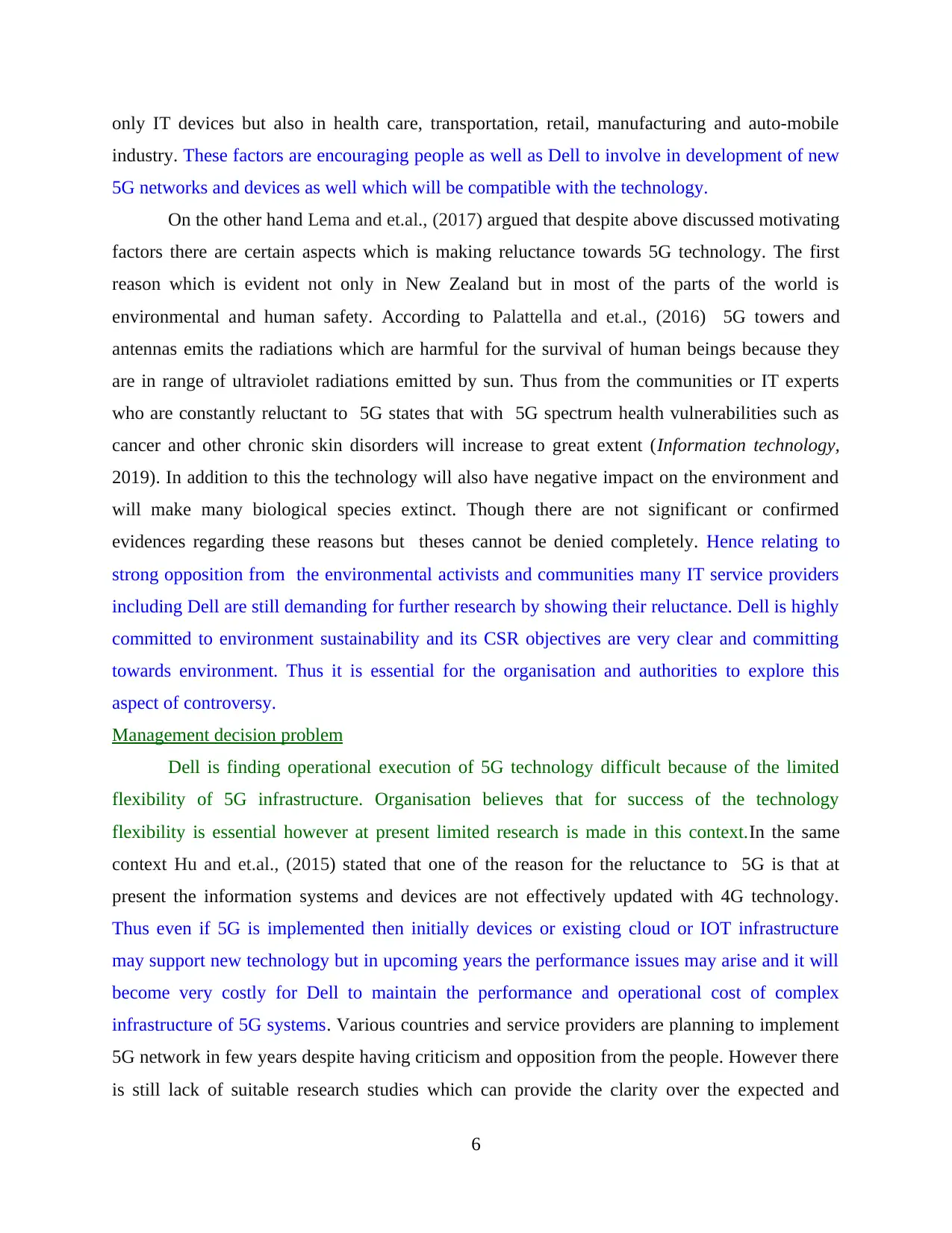
only IT devices but also in health care, transportation, retail, manufacturing and auto-mobile
industry. These factors are encouraging people as well as Dell to involve in development of new
5G networks and devices as well which will be compatible with the technology.
On the other hand Lema and et.al., (2017) argued that despite above discussed motivating
factors there are certain aspects which is making reluctance towards 5G technology. The first
reason which is evident not only in New Zealand but in most of the parts of the world is
environmental and human safety. According to Palattella and et.al., (2016) 5G towers and
antennas emits the radiations which are harmful for the survival of human beings because they
are in range of ultraviolet radiations emitted by sun. Thus from the communities or IT experts
who are constantly reluctant to 5G states that with 5G spectrum health vulnerabilities such as
cancer and other chronic skin disorders will increase to great extent (Information technology,
2019). In addition to this the technology will also have negative impact on the environment and
will make many biological species extinct. Though there are not significant or confirmed
evidences regarding these reasons but theses cannot be denied completely. Hence relating to
strong opposition from the environmental activists and communities many IT service providers
including Dell are still demanding for further research by showing their reluctance. Dell is highly
committed to environment sustainability and its CSR objectives are very clear and committing
towards environment. Thus it is essential for the organisation and authorities to explore this
aspect of controversy.
Management decision problem
Dell is finding operational execution of 5G technology difficult because of the limited
flexibility of 5G infrastructure. Organisation believes that for success of the technology
flexibility is essential however at present limited research is made in this context.In the same
context Hu and et.al., (2015) stated that one of the reason for the reluctance to 5G is that at
present the information systems and devices are not effectively updated with 4G technology.
Thus even if 5G is implemented then initially devices or existing cloud or IOT infrastructure
may support new technology but in upcoming years the performance issues may arise and it will
become very costly for Dell to maintain the performance and operational cost of complex
infrastructure of 5G systems. Various countries and service providers are planning to implement
5G network in few years despite having criticism and opposition from the people. However there
is still lack of suitable research studies which can provide the clarity over the expected and
6
industry. These factors are encouraging people as well as Dell to involve in development of new
5G networks and devices as well which will be compatible with the technology.
On the other hand Lema and et.al., (2017) argued that despite above discussed motivating
factors there are certain aspects which is making reluctance towards 5G technology. The first
reason which is evident not only in New Zealand but in most of the parts of the world is
environmental and human safety. According to Palattella and et.al., (2016) 5G towers and
antennas emits the radiations which are harmful for the survival of human beings because they
are in range of ultraviolet radiations emitted by sun. Thus from the communities or IT experts
who are constantly reluctant to 5G states that with 5G spectrum health vulnerabilities such as
cancer and other chronic skin disorders will increase to great extent (Information technology,
2019). In addition to this the technology will also have negative impact on the environment and
will make many biological species extinct. Though there are not significant or confirmed
evidences regarding these reasons but theses cannot be denied completely. Hence relating to
strong opposition from the environmental activists and communities many IT service providers
including Dell are still demanding for further research by showing their reluctance. Dell is highly
committed to environment sustainability and its CSR objectives are very clear and committing
towards environment. Thus it is essential for the organisation and authorities to explore this
aspect of controversy.
Management decision problem
Dell is finding operational execution of 5G technology difficult because of the limited
flexibility of 5G infrastructure. Organisation believes that for success of the technology
flexibility is essential however at present limited research is made in this context.In the same
context Hu and et.al., (2015) stated that one of the reason for the reluctance to 5G is that at
present the information systems and devices are not effectively updated with 4G technology.
Thus even if 5G is implemented then initially devices or existing cloud or IOT infrastructure
may support new technology but in upcoming years the performance issues may arise and it will
become very costly for Dell to maintain the performance and operational cost of complex
infrastructure of 5G systems. Various countries and service providers are planning to implement
5G network in few years despite having criticism and opposition from the people. However there
is still lack of suitable research studies which can provide the clarity over the expected and
6
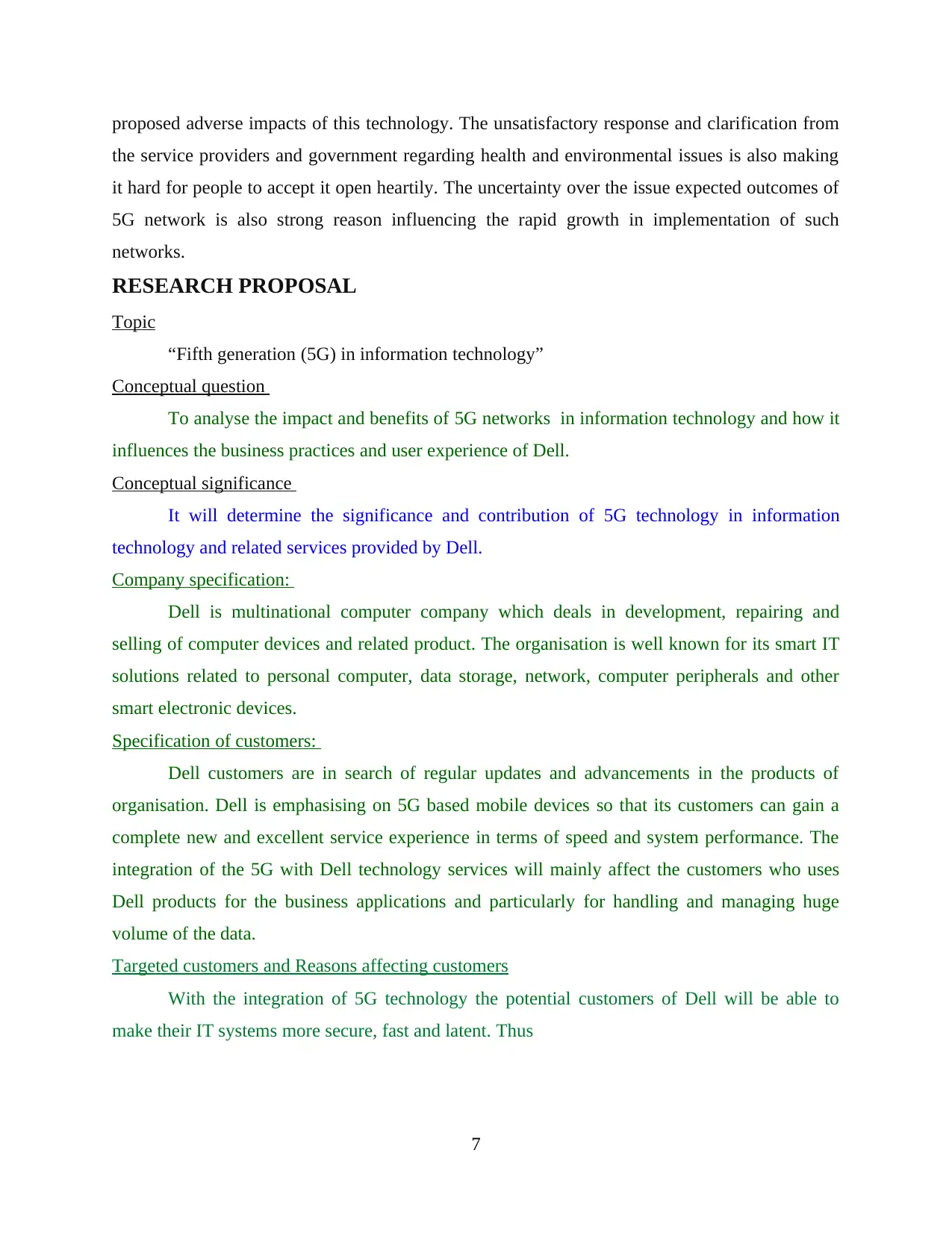
proposed adverse impacts of this technology. The unsatisfactory response and clarification from
the service providers and government regarding health and environmental issues is also making
it hard for people to accept it open heartily. The uncertainty over the issue expected outcomes of
5G network is also strong reason influencing the rapid growth in implementation of such
networks.
RESEARCH PROPOSAL
Topic
“Fifth generation (5G) in information technology”
Conceptual question
To analyse the impact and benefits of 5G networks in information technology and how it
influences the business practices and user experience of Dell.
Conceptual significance
It will determine the significance and contribution of 5G technology in information
technology and related services provided by Dell.
Company specification:
Dell is multinational computer company which deals in development, repairing and
selling of computer devices and related product. The organisation is well known for its smart IT
solutions related to personal computer, data storage, network, computer peripherals and other
smart electronic devices.
Specification of customers:
Dell customers are in search of regular updates and advancements in the products of
organisation. Dell is emphasising on 5G based mobile devices so that its customers can gain a
complete new and excellent service experience in terms of speed and system performance. The
integration of the 5G with Dell technology services will mainly affect the customers who uses
Dell products for the business applications and particularly for handling and managing huge
volume of the data.
Targeted customers and Reasons affecting customers
With the integration of 5G technology the potential customers of Dell will be able to
make their IT systems more secure, fast and latent. Thus
7
the service providers and government regarding health and environmental issues is also making
it hard for people to accept it open heartily. The uncertainty over the issue expected outcomes of
5G network is also strong reason influencing the rapid growth in implementation of such
networks.
RESEARCH PROPOSAL
Topic
“Fifth generation (5G) in information technology”
Conceptual question
To analyse the impact and benefits of 5G networks in information technology and how it
influences the business practices and user experience of Dell.
Conceptual significance
It will determine the significance and contribution of 5G technology in information
technology and related services provided by Dell.
Company specification:
Dell is multinational computer company which deals in development, repairing and
selling of computer devices and related product. The organisation is well known for its smart IT
solutions related to personal computer, data storage, network, computer peripherals and other
smart electronic devices.
Specification of customers:
Dell customers are in search of regular updates and advancements in the products of
organisation. Dell is emphasising on 5G based mobile devices so that its customers can gain a
complete new and excellent service experience in terms of speed and system performance. The
integration of the 5G with Dell technology services will mainly affect the customers who uses
Dell products for the business applications and particularly for handling and managing huge
volume of the data.
Targeted customers and Reasons affecting customers
With the integration of 5G technology the potential customers of Dell will be able to
make their IT systems more secure, fast and latent. Thus
7

Three potential practical applications
Information technology has been an integral part of the business. Thus attributes such as
speed, system maintenance, cost, complexity and performance of these systems influences the
success of business to great extent. The first application of 5G in IT industry will be observed in
terms of its performance. 5G will bring great improvements in terms of system speed, data
transfer rates, latency, architecture and system performance (Galinina and et.al., 2016). Another
practical aspect of industry which will be affected by 5G is security and infrastructure
requirements.
Despite several benefits the new technology will have considerable challenges in
ensuring the privacy and optimum performance characteristics of information systems and
devices. The third practical implication is in the form of infrastructural challenges and
complexities of 5G networks. However it cannot be denied that use of 5G will allow
information systems to achieve new heights of performance excellence such as high data transfer
rates, fewer incidences of system failure and better connectivity and accessibility points for the
service users and business (Abdelwahab and et.al., 2016). In the wake of benefits the limitations
of the technology must not be neglected by the IT service providers. However these applications
will enhance the business capabilities and the customer experience as well as potential of growth
for businesses.
Research problem
To evaluate the impact of 5G technologies on business practices of Dell.
Hypothesis
The results will demonstrate the vast range of benefits and operational changes which
will be observed in IT industry on adoption or implementation of 5G. It will also show the
various challenges and drawbacks which can affect the IT industry in negative manner.
METHODOLOGY
Research type
The research can be of qualitative or quantitative type. The qualitative studies uses
descriptive data or the features. It is mainly based upon observations or ethnography. On the
other hand quantitative studies uses numerical or statistical data which are collected by
correlation or experiments (Haggerty, 2016). Quantitative studies gives very narrow study
outcomes and are complex. This study is of qualitative type so that more generalised results can
8
Information technology has been an integral part of the business. Thus attributes such as
speed, system maintenance, cost, complexity and performance of these systems influences the
success of business to great extent. The first application of 5G in IT industry will be observed in
terms of its performance. 5G will bring great improvements in terms of system speed, data
transfer rates, latency, architecture and system performance (Galinina and et.al., 2016). Another
practical aspect of industry which will be affected by 5G is security and infrastructure
requirements.
Despite several benefits the new technology will have considerable challenges in
ensuring the privacy and optimum performance characteristics of information systems and
devices. The third practical implication is in the form of infrastructural challenges and
complexities of 5G networks. However it cannot be denied that use of 5G will allow
information systems to achieve new heights of performance excellence such as high data transfer
rates, fewer incidences of system failure and better connectivity and accessibility points for the
service users and business (Abdelwahab and et.al., 2016). In the wake of benefits the limitations
of the technology must not be neglected by the IT service providers. However these applications
will enhance the business capabilities and the customer experience as well as potential of growth
for businesses.
Research problem
To evaluate the impact of 5G technologies on business practices of Dell.
Hypothesis
The results will demonstrate the vast range of benefits and operational changes which
will be observed in IT industry on adoption or implementation of 5G. It will also show the
various challenges and drawbacks which can affect the IT industry in negative manner.
METHODOLOGY
Research type
The research can be of qualitative or quantitative type. The qualitative studies uses
descriptive data or the features. It is mainly based upon observations or ethnography. On the
other hand quantitative studies uses numerical or statistical data which are collected by
correlation or experiments (Haggerty, 2016). Quantitative studies gives very narrow study
outcomes and are complex. This study is of qualitative type so that more generalised results can
8
Secure Best Marks with AI Grader
Need help grading? Try our AI Grader for instant feedback on your assignments.

be obtained. Another benefit of using qualitative study is that it is highly flexible and easy to
collect and analyse the data. Qualitative studies can also be accomplished with small sample size
and thus leading to low cost and less time consuming studies without affect quality of research.
Research approach
It describes the systematic pathway for completing the research. It is of three types:
inductive, deductive and abductive. Deductive approach is suitable for mainly quantitative
studies and thus it is not used in this study. This research uses inductive approach in which huge
range of evidences, analysis and evaluation is conducted to develop suitable reasoning for the
collected data. It is kind of action research in which given research topic is analyzed and its
appropriate solutions are determined. Use of inductive approach is also helpful to understand all
aspects of the research problem or subject (Quinlan and et.al., 2019).
Research philosophy
It provides essential knowledge required to conduct the research. Realism philosophy is
suitable for scientific studies while positivism philosophy is usually employed for quantitative
data. Thus in this study interpretivism philosophy is used in which various research elements are
analysed and evaluated so that in depth understanding of the research topic can be developed
(Metcalf and Crawford, 2016). This philosophy is helpful in making research highly effective
because it includes trust worthy and valid data which is also applicable and suitable for small
sample size data.
Data collection
Data can be collected through primary as well as secondary methods. Secondary data is
collected from sources such as books, journals and previous research works while primary data is
collected by the researchers in new research setting for the first time. In this study primary data
collection is used and interview is conducted to collect the data from targeted population.
Secondary data is easily accessible but it may not be specific or advanced as per the research
needs (Ryen, 2016). Though primary data is time consuming and costly but it is highly specific
to the research topic and gives the most relevant and latest insight of the topic.
Sampling
For making the study feasible small population size is chosen for the data collection. In
this study probability or simple random sampling is used in which each member of population
has equal probability of being chosen for the study (Dove and et.al., 2016). The participants are
9
collect and analyse the data. Qualitative studies can also be accomplished with small sample size
and thus leading to low cost and less time consuming studies without affect quality of research.
Research approach
It describes the systematic pathway for completing the research. It is of three types:
inductive, deductive and abductive. Deductive approach is suitable for mainly quantitative
studies and thus it is not used in this study. This research uses inductive approach in which huge
range of evidences, analysis and evaluation is conducted to develop suitable reasoning for the
collected data. It is kind of action research in which given research topic is analyzed and its
appropriate solutions are determined. Use of inductive approach is also helpful to understand all
aspects of the research problem or subject (Quinlan and et.al., 2019).
Research philosophy
It provides essential knowledge required to conduct the research. Realism philosophy is
suitable for scientific studies while positivism philosophy is usually employed for quantitative
data. Thus in this study interpretivism philosophy is used in which various research elements are
analysed and evaluated so that in depth understanding of the research topic can be developed
(Metcalf and Crawford, 2016). This philosophy is helpful in making research highly effective
because it includes trust worthy and valid data which is also applicable and suitable for small
sample size data.
Data collection
Data can be collected through primary as well as secondary methods. Secondary data is
collected from sources such as books, journals and previous research works while primary data is
collected by the researchers in new research setting for the first time. In this study primary data
collection is used and interview is conducted to collect the data from targeted population.
Secondary data is easily accessible but it may not be specific or advanced as per the research
needs (Ryen, 2016). Though primary data is time consuming and costly but it is highly specific
to the research topic and gives the most relevant and latest insight of the topic.
Sampling
For making the study feasible small population size is chosen for the data collection. In
this study probability or simple random sampling is used in which each member of population
has equal probability of being chosen for the study (Dove and et.al., 2016). The participants are
9

chosen randomly so that bias can be avoided and more effective and accurate outcomes can be
obtained. For this study 50 IT professionals are chosen on random basis who are working in IT
industry. Another advantage of using this sampling is that it is very easy to chose the sample
population so that data can be collected quickly.
QUESTIONNAIRE
Ethical considerations
While conducting interview privacy and dignity of the participants must be respected.
Researcher must have informed consent of the participants (Metcalf and Crawford, 2016).
During interview the confidentiality of participants must be protected and they must also be
allowed to skip any question if they do not want to answer.
Questions
The interview questions for the participants are as follows:
INTEVIEW QUESTIONS
Have you heard about 5G technology?
What limitations of 4G network do you feel affect the customer services and benefits
of Dell?
In future will you show acceptance of 5G networks for your IOT devices?
In your opinion what are the advantages of adopting 5G in your business?
Do you think there will be any security risks of 5G network?
What possible challenges your organisation may face while shifting from 4G to 5G
technology?
Do you believe that 5G will provide effective solution for existing problems faced by
Dell?
How will you respond to customer needs with changing scenario of virtualisation and
emergence of 5G technology?
In your opinion if Dell shifts to 5G technology then does existing security protocols are
sufficient or they need improvements?
What will be the economic impact of integrating your IT systems with 5G?
In your opinion what are challenges and limitations of 5G technology.
Does environmental issues related to 5G will create obstacle and challenges for CSR
10
obtained. For this study 50 IT professionals are chosen on random basis who are working in IT
industry. Another advantage of using this sampling is that it is very easy to chose the sample
population so that data can be collected quickly.
QUESTIONNAIRE
Ethical considerations
While conducting interview privacy and dignity of the participants must be respected.
Researcher must have informed consent of the participants (Metcalf and Crawford, 2016).
During interview the confidentiality of participants must be protected and they must also be
allowed to skip any question if they do not want to answer.
Questions
The interview questions for the participants are as follows:
INTEVIEW QUESTIONS
Have you heard about 5G technology?
What limitations of 4G network do you feel affect the customer services and benefits
of Dell?
In future will you show acceptance of 5G networks for your IOT devices?
In your opinion what are the advantages of adopting 5G in your business?
Do you think there will be any security risks of 5G network?
What possible challenges your organisation may face while shifting from 4G to 5G
technology?
Do you believe that 5G will provide effective solution for existing problems faced by
Dell?
How will you respond to customer needs with changing scenario of virtualisation and
emergence of 5G technology?
In your opinion if Dell shifts to 5G technology then does existing security protocols are
sufficient or they need improvements?
What will be the economic impact of integrating your IT systems with 5G?
In your opinion what are challenges and limitations of 5G technology.
Does environmental issues related to 5G will create obstacle and challenges for CSR
10

policy of Dell?
What is the strategy of Dell for 5G?
Do you think Dell will be able to meet the 5G demands?
What is the organisational perspective of Dell towards 5G and its impact on customers
of Dell?
11
What is the strategy of Dell for 5G?
Do you think Dell will be able to meet the 5G demands?
What is the organisational perspective of Dell towards 5G and its impact on customers
of Dell?
11
Paraphrase This Document
Need a fresh take? Get an instant paraphrase of this document with our AI Paraphraser
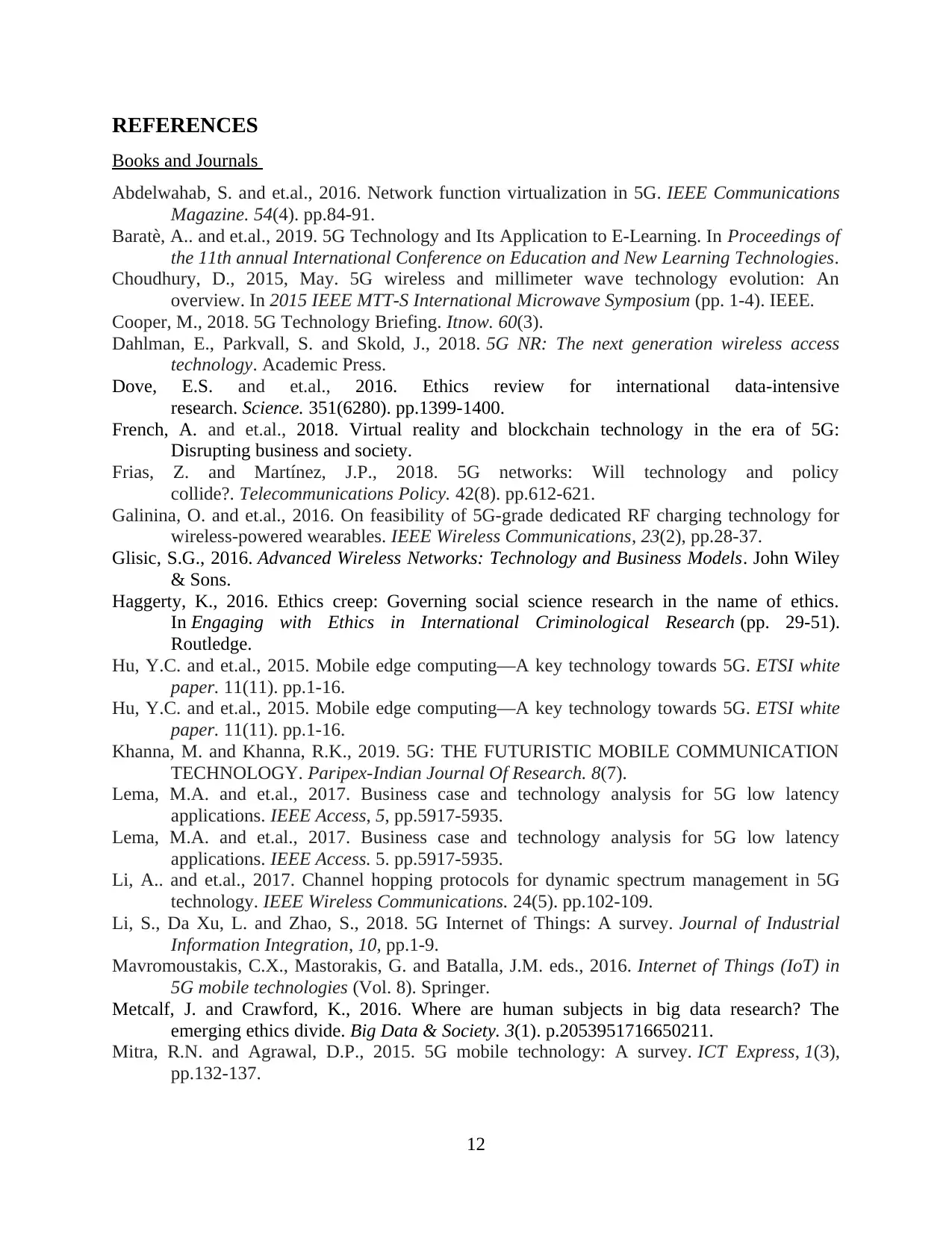
REFERENCES
Books and Journals
Abdelwahab, S. and et.al., 2016. Network function virtualization in 5G. IEEE Communications
Magazine. 54(4). pp.84-91.
Baratè, A.. and et.al., 2019. 5G Technology and Its Application to E-Learning. In Proceedings of
the 11th annual International Conference on Education and New Learning Technologies.
Choudhury, D., 2015, May. 5G wireless and millimeter wave technology evolution: An
overview. In 2015 IEEE MTT-S International Microwave Symposium (pp. 1-4). IEEE.
Cooper, M., 2018. 5G Technology Briefing. Itnow. 60(3).
Dahlman, E., Parkvall, S. and Skold, J., 2018. 5G NR: The next generation wireless access
technology. Academic Press.
Dove, E.S. and et.al., 2016. Ethics review for international data-intensive
research. Science. 351(6280). pp.1399-1400.
French, A. and et.al., 2018. Virtual reality and blockchain technology in the era of 5G:
Disrupting business and society.
Frias, Z. and Martínez, J.P., 2018. 5G networks: Will technology and policy
collide?. Telecommunications Policy. 42(8). pp.612-621.
Galinina, O. and et.al., 2016. On feasibility of 5G-grade dedicated RF charging technology for
wireless-powered wearables. IEEE Wireless Communications, 23(2), pp.28-37.
Glisic, S.G., 2016. Advanced Wireless Networks: Technology and Business Models. John Wiley
& Sons.
Haggerty, K., 2016. Ethics creep: Governing social science research in the name of ethics.
In Engaging with Ethics in International Criminological Research (pp. 29-51).
Routledge.
Hu, Y.C. and et.al., 2015. Mobile edge computing—A key technology towards 5G. ETSI white
paper. 11(11). pp.1-16.
Hu, Y.C. and et.al., 2015. Mobile edge computing—A key technology towards 5G. ETSI white
paper. 11(11). pp.1-16.
Khanna, M. and Khanna, R.K., 2019. 5G: THE FUTURISTIC MOBILE COMMUNICATION
TECHNOLOGY. Paripex-Indian Journal Of Research. 8(7).
Lema, M.A. and et.al., 2017. Business case and technology analysis for 5G low latency
applications. IEEE Access, 5, pp.5917-5935.
Lema, M.A. and et.al., 2017. Business case and technology analysis for 5G low latency
applications. IEEE Access. 5. pp.5917-5935.
Li, A.. and et.al., 2017. Channel hopping protocols for dynamic spectrum management in 5G
technology. IEEE Wireless Communications. 24(5). pp.102-109.
Li, S., Da Xu, L. and Zhao, S., 2018. 5G Internet of Things: A survey. Journal of Industrial
Information Integration, 10, pp.1-9.
Mavromoustakis, C.X., Mastorakis, G. and Batalla, J.M. eds., 2016. Internet of Things (IoT) in
5G mobile technologies (Vol. 8). Springer.
Metcalf, J. and Crawford, K., 2016. Where are human subjects in big data research? The
emerging ethics divide. Big Data & Society. 3(1). p.2053951716650211.
Mitra, R.N. and Agrawal, D.P., 2015. 5G mobile technology: A survey. ICT Express, 1(3),
pp.132-137.
12
Books and Journals
Abdelwahab, S. and et.al., 2016. Network function virtualization in 5G. IEEE Communications
Magazine. 54(4). pp.84-91.
Baratè, A.. and et.al., 2019. 5G Technology and Its Application to E-Learning. In Proceedings of
the 11th annual International Conference on Education and New Learning Technologies.
Choudhury, D., 2015, May. 5G wireless and millimeter wave technology evolution: An
overview. In 2015 IEEE MTT-S International Microwave Symposium (pp. 1-4). IEEE.
Cooper, M., 2018. 5G Technology Briefing. Itnow. 60(3).
Dahlman, E., Parkvall, S. and Skold, J., 2018. 5G NR: The next generation wireless access
technology. Academic Press.
Dove, E.S. and et.al., 2016. Ethics review for international data-intensive
research. Science. 351(6280). pp.1399-1400.
French, A. and et.al., 2018. Virtual reality and blockchain technology in the era of 5G:
Disrupting business and society.
Frias, Z. and Martínez, J.P., 2018. 5G networks: Will technology and policy
collide?. Telecommunications Policy. 42(8). pp.612-621.
Galinina, O. and et.al., 2016. On feasibility of 5G-grade dedicated RF charging technology for
wireless-powered wearables. IEEE Wireless Communications, 23(2), pp.28-37.
Glisic, S.G., 2016. Advanced Wireless Networks: Technology and Business Models. John Wiley
& Sons.
Haggerty, K., 2016. Ethics creep: Governing social science research in the name of ethics.
In Engaging with Ethics in International Criminological Research (pp. 29-51).
Routledge.
Hu, Y.C. and et.al., 2015. Mobile edge computing—A key technology towards 5G. ETSI white
paper. 11(11). pp.1-16.
Hu, Y.C. and et.al., 2015. Mobile edge computing—A key technology towards 5G. ETSI white
paper. 11(11). pp.1-16.
Khanna, M. and Khanna, R.K., 2019. 5G: THE FUTURISTIC MOBILE COMMUNICATION
TECHNOLOGY. Paripex-Indian Journal Of Research. 8(7).
Lema, M.A. and et.al., 2017. Business case and technology analysis for 5G low latency
applications. IEEE Access, 5, pp.5917-5935.
Lema, M.A. and et.al., 2017. Business case and technology analysis for 5G low latency
applications. IEEE Access. 5. pp.5917-5935.
Li, A.. and et.al., 2017. Channel hopping protocols for dynamic spectrum management in 5G
technology. IEEE Wireless Communications. 24(5). pp.102-109.
Li, S., Da Xu, L. and Zhao, S., 2018. 5G Internet of Things: A survey. Journal of Industrial
Information Integration, 10, pp.1-9.
Mavromoustakis, C.X., Mastorakis, G. and Batalla, J.M. eds., 2016. Internet of Things (IoT) in
5G mobile technologies (Vol. 8). Springer.
Metcalf, J. and Crawford, K., 2016. Where are human subjects in big data research? The
emerging ethics divide. Big Data & Society. 3(1). p.2053951716650211.
Mitra, R.N. and Agrawal, D.P., 2015. 5G mobile technology: A survey. ICT Express, 1(3),
pp.132-137.
12
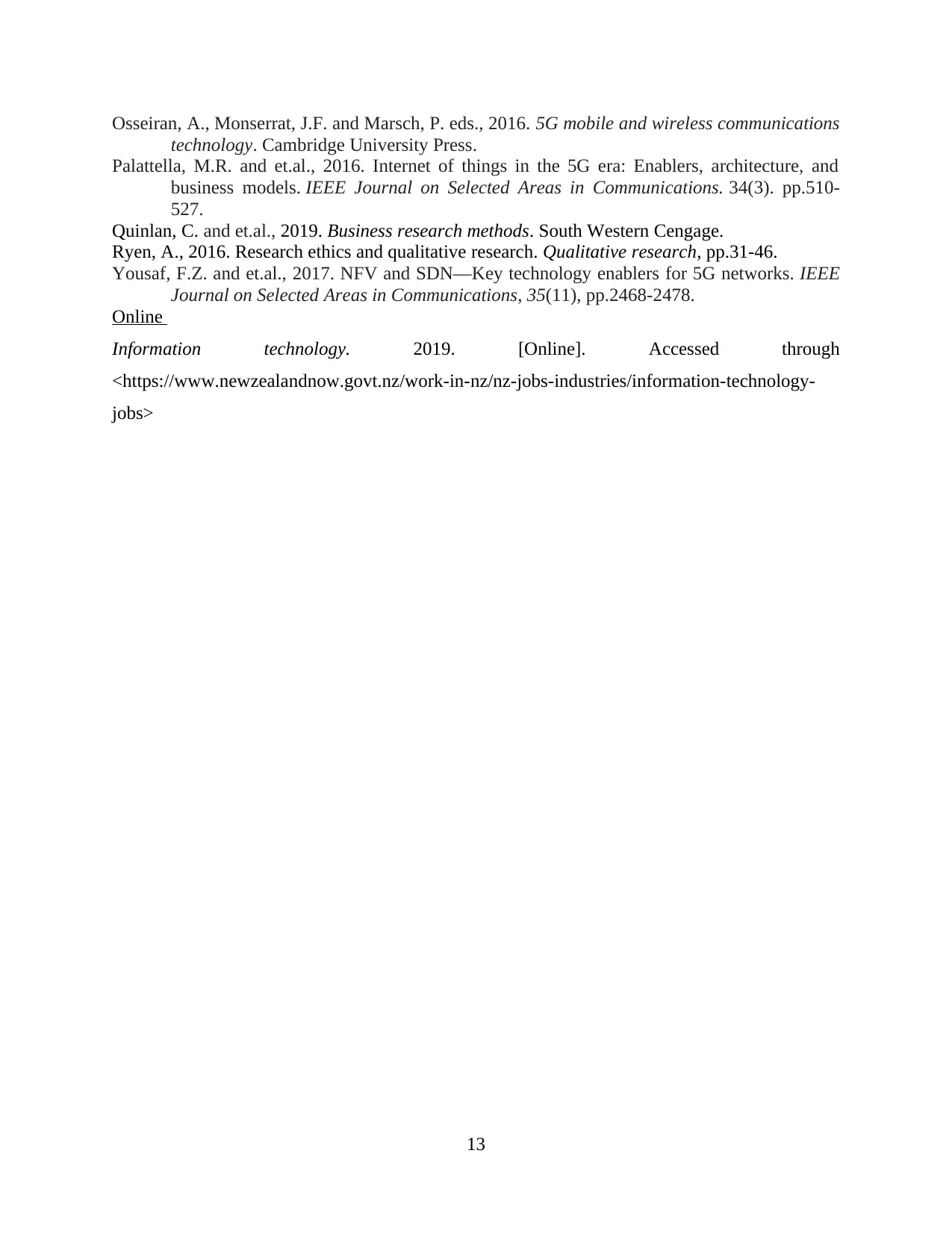
Osseiran, A., Monserrat, J.F. and Marsch, P. eds., 2016. 5G mobile and wireless communications
technology. Cambridge University Press.
Palattella, M.R. and et.al., 2016. Internet of things in the 5G era: Enablers, architecture, and
business models. IEEE Journal on Selected Areas in Communications. 34(3). pp.510-
527.
Quinlan, C. and et.al., 2019. Business research methods. South Western Cengage.
Ryen, A., 2016. Research ethics and qualitative research. Qualitative research, pp.31-46.
Yousaf, F.Z. and et.al., 2017. NFV and SDN—Key technology enablers for 5G networks. IEEE
Journal on Selected Areas in Communications, 35(11), pp.2468-2478.
Online
Information technology. 2019. [Online]. Accessed through
<https://www.newzealandnow.govt.nz/work-in-nz/nz-jobs-industries/information-technology-
jobs>
13
technology. Cambridge University Press.
Palattella, M.R. and et.al., 2016. Internet of things in the 5G era: Enablers, architecture, and
business models. IEEE Journal on Selected Areas in Communications. 34(3). pp.510-
527.
Quinlan, C. and et.al., 2019. Business research methods. South Western Cengage.
Ryen, A., 2016. Research ethics and qualitative research. Qualitative research, pp.31-46.
Yousaf, F.Z. and et.al., 2017. NFV and SDN—Key technology enablers for 5G networks. IEEE
Journal on Selected Areas in Communications, 35(11), pp.2468-2478.
Online
Information technology. 2019. [Online]. Accessed through
<https://www.newzealandnow.govt.nz/work-in-nz/nz-jobs-industries/information-technology-
jobs>
13
1 out of 15
Related Documents
Your All-in-One AI-Powered Toolkit for Academic Success.
+13062052269
info@desklib.com
Available 24*7 on WhatsApp / Email
![[object Object]](/_next/static/media/star-bottom.7253800d.svg)
Unlock your academic potential
© 2024 | Zucol Services PVT LTD | All rights reserved.





